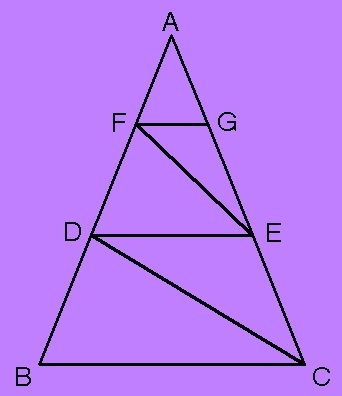Finding the area of a triangle
 In the triangle shown above,
D
E
∣
∣
B
C
,
F
E
∣
∣
D
C
,
A
F
=
8
,
F
D
=
1
0
,
B
C
=
4
0
.
5
and
A
B
=
A
C
. Find the area of
△
A
B
C
correct to
5
decimal places.
In the triangle shown above,
D
E
∣
∣
B
C
,
F
E
∣
∣
D
C
,
A
F
=
8
,
F
D
=
1
0
,
B
C
=
4
0
.
5
and
A
B
=
A
C
. Find the area of
△
A
B
C
correct to
5
decimal places.
Note: The drawing is not drawn true to scale.
The answer is 710.24908.
This section requires Javascript.
You are seeing this because something didn't load right. We suggest you, (a) try
refreshing the page, (b) enabling javascript if it is disabled on your browser and,
finally, (c)
loading the
non-javascript version of this page
. We're sorry about the hassle.
2 solutions
Consider △ A D C
F D A F = E C A E
1 0 8 = E C A E
5 4 = E C A E ( 1 )
Consider △ A B C
D B A D = E C A E
D B 1 8 = E C A E ( 2 )
Equate ( 1 ) and ( 2 )
5 4 = D B 1 8
4 ( D B ) = ( 5 ) ( 1 8 )
D B = 2 2 . 5
It follows that
A B = 8 + 1 0 + 2 2 . 5 = 4 0 . 5
Therefore, △ A B C is an equilateral triangle.
The formula for the area of an equilateral triangle is given by A = 4 s 2 3 where s = side length
Substituting, we obtain
A = 4 4 0 . 5 2 3 = 7 1 0 . 2 4 9 0 8 answer
Used almost the same method.
Let B D = x . Note that A F = A G , F D = G E and B D = C E = x . Since F E ∣ ∣ D C , we have:
A E E C A G + G E B D A F + F D B D 8 + 1 0 x ⟹ x ⟹ A B = A F F D = 8 1 0 = 8 1 0 = 8 1 0 = 8 1 8 × 1 0 = 2 2 . 5 = A F + F D + B D = 8 + 1 0 + 2 2 . 5 = 4 0 . 5
Since A B = A C = B C = 4 0 . 5 , t r i a n g l e A B C is equilateral and its area is 2 1 × 4 0 . 5 2 × 2 3 ≈ 7 1 0 . 2 4 9 0 8